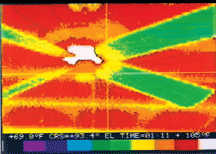 |
|
Got an Environmental Question? Send it to: EARTH TALK, c/o E/The Environmental Magazine, P.O. Box 5098, Westport, CT 06881. Or submit your question at: www.emagazine.com. Or e-mail us at: [email protected].
From the Editors of E/The Environmental Magazine
|
Keep Cool Without the Heavy Footprint
Beating the heat doesn’t have to mean blasting your air conditioning
Summer’s already a scorcher this year, and I’d like to know how I can keep cool indoors without just running my energy-hogging air conditioners all the time. Any tips?
–John McGovern, Cohasset, Mass.
The movement of air over the skin is what’s key to keeping the body cool, according to Harvey Sachs of the non-profit American Council for an Energy-Efficient Economy. So instead of turning on air conditioning, see which direction the breeze is blowing outside (no matter how minimal it may be), then open a few windows strategically to try to get it flowing through the house from end-to-end or side-to-side.
If the breeze alone isn’t enough, apply some fan power. Even small tabletop fans, which can be had for $30 or so at Target and similar stores, can really whip the air around. Placing one facing in by a window where air is coming in and one at an opposite window positioned to blow warm air out, can create a wind tunnel effect in pulling air through the house.
This strategy can be especially effective at night when it is cooler. But then it’s important to shut the windows when you leave for the day in the morning to keep the cooler air in and the warmth of the new day out. Keep blinds shut and curtains drawn, too, as sunlight pouring into the house only creates more heat. Remember that lights left on are not only wasting electricity — they’re creating heat, as well.
Ceiling fans also do a nice job of circulating air in the rooms you occupy most, and though they do require some up-front costs for installation they use only about one-thirtieth the electricity of a room air conditioner.
Beyond moving the air around to keep cool, the website WikiHow.com lists several tips for using water to keep cool sans AC. One tried-and-true method is to wet your wrists and other pulse points with cold water, and then keep those spots cool by holding an ice cube wrapped in a face cloth against them. The relief is immediate, and this method will cool down the entire body — by as much as three degrees — for upwards of an hour. Another WikiHow suggestion: Wear a short-sleeved shirt and keep the sleeves wet with cold water (from a squirt bottle, faucet or hose). Keeping the pant legs of long pants wet is also a good way to keep your legs cool. Add in a breeze or a fan, and you can actually get cold.
Of course, if you just can’t live without air conditioning, there are greener options out there. For starters, a single window unit that keeps one room cool is far less energy intensive and polluting than central air conditioning that keeps all the rooms in the house (including those you’re not using) cool. Look for new models sporting the federal Energy Star label, which marks units as energy efficient.
Another option for those in hot, dry climates is an evaporative cooler, which cools outdoor air through evaporation and blows it inside the house. These units make for a nice alternative to traditional central air conditioning, as they cost about half as much to install and use only one-quarter of the energy overall.
For more information:
• American Council for an Energy-Efficient Economy: www.aceee.org.
• WikiHow: www.wikihow.com.
• Energy Star: www.energystar.gov.
Got an environmental question? Send it to: EarthTalk, c/o E/The Environmental Magazine, P.O. Box 5098, Westport, CT 06881; submit it at www.emagazine.com/earthtalk/thisweek: or e-mail [email protected]. Read past columns at: www.emagazine.com/earthtalk/archives.php.